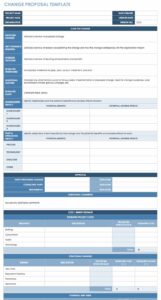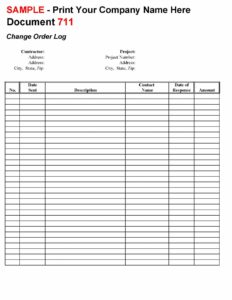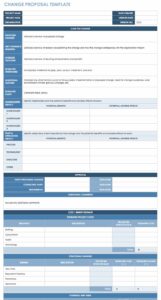Utilizing such a structured approach offers several advantages. It minimizes misunderstandings by providing a clear framework for requesting and implementing changes. It streamlines the approval process by ensuring all necessary information is readily available to stakeholders. Furthermore, it establishes a robust audit trail, facilitating better contract management and reducing potential disputes.
The subsequent sections will delve into the key components of these forms, best practices for their implementation, and common challenges encountered during the change management process.
Key Components of a Contract Change Request Form
Effective management of contract modifications requires a structured approach. A well-designed form ensures all essential information is captured, facilitating clear communication and efficient processing. The following components are typically considered crucial:
1. Identification of Original Contract: Clear identification of the original agreement, including contract name, number, and effective date, is paramount.
2. Requestor Information: Details of the individual or entity requesting the change, including their contact information, are essential for communication and accountability.
3. Description of Change: A concise and unambiguous description of the proposed modification, outlining the specific clauses or sections affected, is vital for clarity.
4. Rationale for Change: A clear explanation of the reasons necessitating the change provides context and justification for the requested modification.
5. Impact Assessment: An evaluation of the potential impact of the change on various aspects of the contract, such as cost, schedule, and deliverables, is crucial for informed decision-making.
6. Proposed Revised Language: Providing the specific revised wording for the affected clauses ensures clarity and minimizes ambiguity.
7. Approval Section: Designated spaces for relevant stakeholders to sign off on the proposed change ensure proper authorization and accountability.
8. Effective Date of Change: Specifying the date the change becomes effective provides clarity and avoids potential disputes.
These components provide a comprehensive framework for documenting and managing contract changes, enabling efficient processing, minimizing errors, and ensuring all parties are informed and aligned.
How to Create a Contract Change Request Template
Developing a standardized template for contract change requests promotes consistency and efficiency in managing contract modifications. A well-structured template ensures all necessary information is captured and facilitates a clear approval process. The following steps outline the process of creating such a template.
1: Define Scope and Purpose: Clearly define the types of contracts and changes the template will cover. This ensures the template remains relevant and focused.
2: Identify Key Stakeholders: Determine the individuals or departments involved in the contract change process and incorporate their input into the template design.
3: Incorporate Essential Fields: Include fields for capturing essential information such as original contract details, requestor information, description of change, rationale, impact assessment, proposed revised language, approval sections, and effective date.
4: Establish Clear Instructions: Provide clear and concise instructions on how to complete each section of the template to minimize errors and ensure consistency.
5: Utilize a User-Friendly Format: Adopt a clear and logical layout that facilitates easy navigation and completion. Employing numbered sections and headings enhances readability.
6: Implement Version Control: Establish a version control system to track revisions and ensure users are utilizing the most current version of the template.
7: Provide Training and Support: Offer training and support to users on how to effectively utilize the template and navigate the change request process.
8: Regularly Review and Update: Periodically review and update the template based on user feedback and evolving business needs to maintain its effectiveness and relevance.
A robust template provides a structured framework, facilitating clear communication, efficient processing, and minimizing potential disputes. By adhering to these steps, organizations can develop a template tailored to their specific requirements, enhancing contract management processes.
Standardized forms for requesting contract modifications provide a crucial mechanism for managing alterations to agreements effectively. These templates ensure clarity, consistency, and traceability by capturing essential information, facilitating a structured approval process, and establishing a robust audit trail. Key components such as clear identification of the original contract, detailed descriptions of the proposed changes, rationale, impact assessments, and designated approval sections contribute to a comprehensive and well-managed change process. Utilizing such templates minimizes misunderstandings, streamlines approvals, and mitigates potential disputes.
Effective implementation of these templates requires careful consideration of organizational needs, stakeholder input, and ongoing review and refinement. Organizations prioritizing a structured approach to contract change management contribute to improved efficiency, reduced risk, and stronger contractual relationships. This proactive approach to change management is essential for navigating the evolving landscape of business agreements and fostering successful long-term partnerships.


